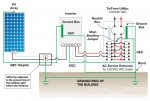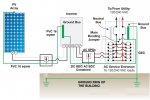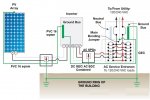THANKS IN ADVANCE
Id like to give a brief explanation about my situation in order to make u understand my ignorance on these issues. I have 2 years of working experience, 1 year as internship working on solar thermal plants simulations and troubleshooting on site, on my second year (already with an engineer contract) ive been developing the automation of biogas generation and biogas upgrading plants, the executives told me that they wanted to introduce photovoltaic systems in our portfolio, so i started to study theory and simulation making simulations. There is no technical supervisor for pv projects here and we dont have any consultant company for advices, and the electrical engineers here (Thailand) dont care about how installers do. Thanks to this forum and information given by suppliers Im having a better idea about how a good installation should be made, so I really appreciate every suggestion given.
The engineers where I work told me that the lighting ground system and and main service ground system were not but after digging a bit I saw that we have one earth ring system for the building where LPS and MDB busbar are connected. There is a lot of controversy about the best PV grounding system when you dont rely on any code and I would like to have the PV parking we are building grounded with the best configuration possible.
After knowing that we have a common earth ring for LPS and building services and with all the information provided by this forum i made two configurations:

On this configuration, all the modules and structure are bonded and connected to a busbar at the array. From the busbar there is an PVC 16sqmm cable going to a 18 m far handhole, from there to the building ring and connected to the SPDs, the same PVC 16sqmm continues to the inverters for ground fault protection.
Although i dont need to rely on NEC code, it says that we can not use EGC as GEC. I dont know if this config I accomplish that
Is this config correct? Would it compromise the groundfault protection of the inverter?
What about this other one?

Here there is a GEC to the handhole and from there to the building ring. SPSs are attached to the GEC at the handhole. An EGC goes from the array busbar directly to the inverter for the groundfault protection. Is this config better?
There are no junction box for parallel connection outside the inverters, each string to its inverter dc input but the thai legislation makes you include a circuit breaker right before the inverter. If I size the EGC according to NEC 250.122. it would be an AWG14 wire but the installers already ran a pvc 16sqmm (they havent connected yet, we are waiting the inverters).
On this second config, the connection from the handhole to the earth ring of the building, should it be by bare copper with the same size than the ring?
Is correct to use both GEC and EGC with the same size 16sqmm although with a much smaller one for EGC would be ok?
In brief,
Which of both would you choose?
What would you change to make it better?
IM A BIT DESPERATE WITH THIS ISSUE SO I REALLY APPRECIATE YOUR HELP
Id like to give a brief explanation about my situation in order to make u understand my ignorance on these issues. I have 2 years of working experience, 1 year as internship working on solar thermal plants simulations and troubleshooting on site, on my second year (already with an engineer contract) ive been developing the automation of biogas generation and biogas upgrading plants, the executives told me that they wanted to introduce photovoltaic systems in our portfolio, so i started to study theory and simulation making simulations. There is no technical supervisor for pv projects here and we dont have any consultant company for advices, and the electrical engineers here (Thailand) dont care about how installers do. Thanks to this forum and information given by suppliers Im having a better idea about how a good installation should be made, so I really appreciate every suggestion given.
The engineers where I work told me that the lighting ground system and and main service ground system were not but after digging a bit I saw that we have one earth ring system for the building where LPS and MDB busbar are connected. There is a lot of controversy about the best PV grounding system when you dont rely on any code and I would like to have the PV parking we are building grounded with the best configuration possible.
After knowing that we have a common earth ring for LPS and building services and with all the information provided by this forum i made two configurations:

On this configuration, all the modules and structure are bonded and connected to a busbar at the array. From the busbar there is an PVC 16sqmm cable going to a 18 m far handhole, from there to the building ring and connected to the SPDs, the same PVC 16sqmm continues to the inverters for ground fault protection.
Although i dont need to rely on NEC code, it says that we can not use EGC as GEC. I dont know if this config I accomplish that
Is this config correct? Would it compromise the groundfault protection of the inverter?
What about this other one?

Here there is a GEC to the handhole and from there to the building ring. SPSs are attached to the GEC at the handhole. An EGC goes from the array busbar directly to the inverter for the groundfault protection. Is this config better?
There are no junction box for parallel connection outside the inverters, each string to its inverter dc input but the thai legislation makes you include a circuit breaker right before the inverter. If I size the EGC according to NEC 250.122. it would be an AWG14 wire but the installers already ran a pvc 16sqmm (they havent connected yet, we are waiting the inverters).
On this second config, the connection from the handhole to the earth ring of the building, should it be by bare copper with the same size than the ring?
Is correct to use both GEC and EGC with the same size 16sqmm although with a much smaller one for EGC would be ok?
In brief,
Which of both would you choose?
What would you change to make it better?
IM A BIT DESPERATE WITH THIS ISSUE SO I REALLY APPRECIATE YOUR HELP







